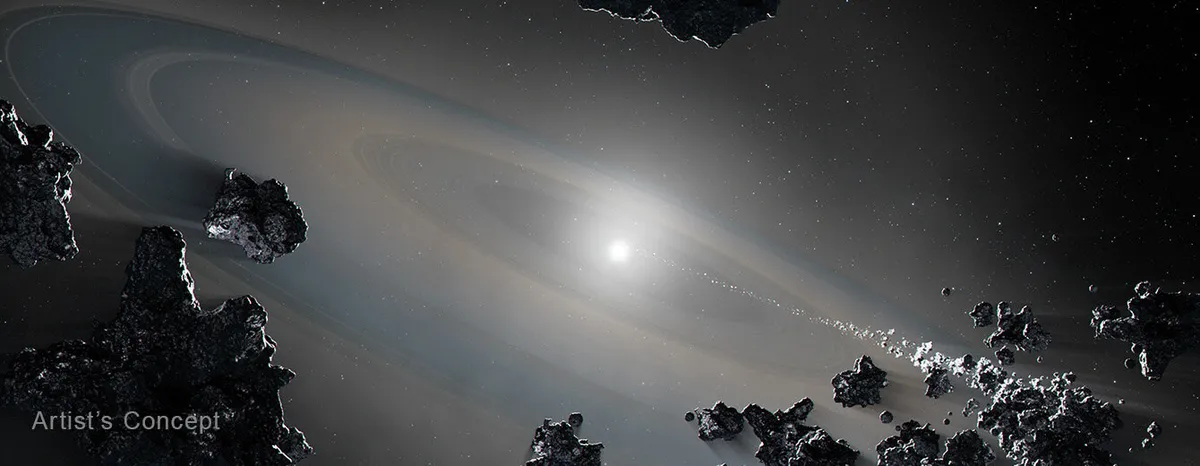
In approximately 5 billion years, our sun will exhaust its hydrogen fuel and undergo a dramatic transformation, collapsing under its own gravity to become a white dwarf. Although this remnant will be Earth-sized, it will retain much of the sun's gravitational influence, signifying the end of our solar system as we currently understand it. However, the universe is in a constant state of flux, and recent astronomical discoveries challenge our assumptions about the late stages of stellar evolution.
Astronomers were astonished to find a 3 billion-year-old white dwarf actively accreting material from its former planetary system. This groundbreaking discovery sheds light on the evolution of stellar remnants and was made possible through observations at the W. M. Keck Observatory on Maunakea, Hawaiʻi. By conducting spectroscopic analysis of the light emitted by the white dwarf, researchers identified 13 chemical elements that originated from a small rocky body, such as an asteroid or dwarf planet.
This phenomenon suggests that some unknown gravitational disturbance occurred within the past few million years, sending an object spiraling inward towards the white dwarf, where it was subsequently torn apart by tidal forces and absorbed into the surrounding debris disk.
Astronomers have identified a rare and ancient planetary system, designated LSPM J0207+3331, located 145 light-years from Earth. This system features the oldest and most metal-rich debris disk ever observed around a hydrogen-rich white dwarf. The discoveries made in this system raise significant questions regarding the long-term stability of planetary systems billions of years post-stellar death.
Lead author Érika Le Bourdais from the Trottier Institute for Research on Exoplanets at the Université de Montréal states, “This discovery challenges our understanding of planetary system evolution.” The ongoing accretion at this stage indicates that white dwarfs may also retain planetary remnants that are still undergoing dynamic changes, which is a revelation in the field of astrophysics.
Data acquired from the W. M. Keck Observatory revealed that the atmosphere of the white dwarf is “polluted” with 13 chemical elements, indicative of a rocky body at least 120 miles (200 kilometers) wide that was disintegrated by the star's gravitational pull. Co-author Patrick Dufour, also from the Université de Montréal, noted that the amount of rocky material present is unusually high for a white dwarf of this age. Typically, hydrogen-rich atmospheres around white dwarfs obscure such elemental signals, making this detection particularly significant.
Co-investigator John Debes from the Space Telescope Science Institute in Baltimore emphasized that something has clearly disturbed this system long after the star's death, indicating a reservoir of material capable of polluting the white dwarf even after billions of years.
Approximately half of all polluted white dwarfs exhibit signs of accreting heavy elements, implying that their planetary systems have experienced dynamic disturbances. In the case of LSPM J0207+3331, a recent perturbation, likely within the last few million years, probably caused a rocky planet to spiral inwards. This discovery suggests that tidal disruption and accretion mechanisms remain operational long after a star has completed its main-sequence phase.
Debes explained that mass loss during stellar evolution can destabilize orbits, affecting planets, comets, and asteroids. This system may represent a case of delayed instability, where interactions among multiple planets gradually destabilize orbits over billions of years. Such findings indicate that there are long-term dynamical processes in planetary systems that we do not fully comprehend yet.
Astronomers are now focused on investigating what may have triggered the disruption within this ancient planetary system. Surviving Jupiter-sized planets could be responsible for the observed changes, but their detection is complicated due to their distance from the white dwarf and low temperatures. Data from the ESA's Gaia space telescope may be sensitive enough to identify such planets by analyzing their gravitational effects on the white dwarf.
Additionally, NASA's James Webb Space Telescope is set to provide further insights through infrared observations aimed at detecting signs of outer planets. Future observations could help distinguish whether the observed changes are the result of a planetary shakeup or the gravitational influence of a stellar close encounter with the white dwarf.